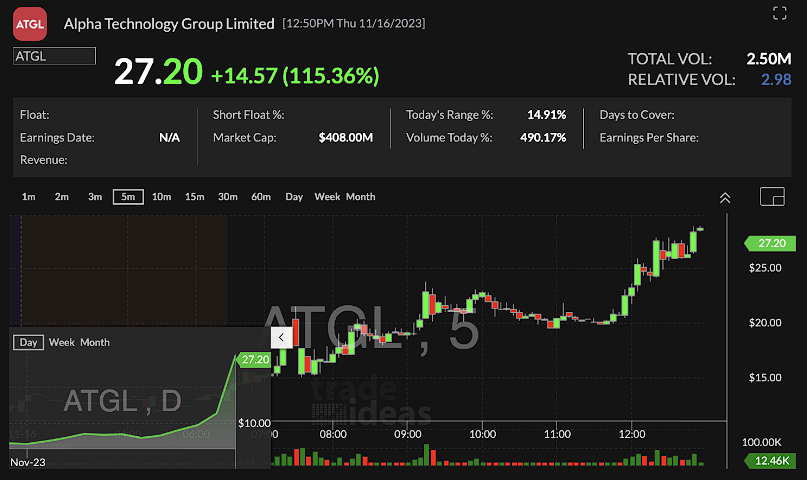
9 Essential Rules for Selecting Stocks When Day Trading By Trade Ideas
Have you considered how vital it is to pick the right stocks in day trading?
Navigating the realm of intraday trading is akin to sailing through swiftly changing currents. In this environment, the art of choosing the right stocks is not just important—it’s essential. Each choice a trader makes carries significant impact, offering both potential gains and challenges.
This article is crafted to simplify and explain the key aspects of stock selection in day trading, outlining eight vital rules. These principles serve as a guide for traders at all levels, helping them to grasp and adjust to the market’s complex nature. We will explore the importance of utilizing up-to-the-minute market data and understanding market volatility and trends, and how these factors are crucial in making well-informed stock choices.
Introduction to Intraday Trading
Intraday trading stands as a unique facet of the financial markets, characterized by the rapid buying and selling of stocks within the same trading day. This approach aims to harness profit from the swift shifts that define the market’s day-to-day rhythm. Contrasting with the long-haul outlook of traditional investing, intraday trading hinges on leveraging the volatility and liquidity of the stock market within hours, if not minutes.
The crux of successful intraday trading lies in the selection of appropriate stocks. Ideal choices are those that balance high liquidity with sufficient volatility. High liquidity ensures smooth transactions without significant price impacts, while volatility provides the necessary price swings to secure profits in a limited time frame.
Within this context, traders often rely on various tools and services to stay informed. While some traders might use platforms like Google Finance or Yahoo Finance for market news and stock updates, others might find additional value in specialized tools that offer more targeted insights such as real-time trading alerts. These tools help traders stay on top of market movements, which is crucial for the quick decision-making required in intraday trading.
Navigating these resources is an essential skill for any intraday trader. It’s not just about understanding the market’s movements; it’s also about effectively harnessing the data and insights from these platforms to spot the most promising trading opportunities. This involves a blend of analytical skills and intuition, honed through experience and continuous engagement with the market.
In summary, intraday trading is a complex yet rewarding endeavor. It requires a fusion of quick strategic thinking, an in-depth grasp of market mechanics, and the adept use of available digital tools. For those who can adeptly navigate these waters, the market presents numerous opportunities for quick, short-term gains.
Criteria for Selecting Stocks
For those immersed in the fast-paced environment of intraday trading, picking the appropriate stocks is pivotal. This process revolves around three key elements: liquidity, volatility, and the relationship with sector and index groups.
Liquidity’s Role: At the heart of effective intraday trading lies the concept of liquidity. When a stock is highly liquid, it means there’s a significant volume of shares being actively traded. This is vital for intraday traders, as it ensures the ease of buying and selling stocks promptly without causing drastic price alterations. Essentially, a liquid stock can handle large trades without significant price changes, offering traders the ability to execute transactions at or near their preferred price points. High liquidity is crucial not only for minimizing the risk of price slippage but also for providing the flexibility to act quickly in response to market fluctuations.
The Importance of Volatility: Another key factor in stock selection is volatility. This term refers to the extent of price changes a stock undergoes in a short period. Intraday traders typically look for stocks with a moderate to high level of volatility, as these stocks offer the price movements needed to make profits within the day. While this does come with increased risk, it also opens up more opportunities for profit. Traders often seek stocks that exhibit significant price shifts, either in dollar value or percentage, as these movements create potential for lucrative trades.
Adapting to the volatility of the market requires not just skill, but also the ability to balance quick decision-making with other daily responsibilities. Many traders face the challenge of integrating their trading activities with full-time jobs or other commitments. Successfully managing this balance, much like navigating market volatility, is a skill that can be honed with practice and the right guidance.
Understanding Sector and Index Correlations: The third aspect to consider is how closely a stock’s movements align with its sector or major market indices. Stocks that demonstrate a strong correlation with their sector or indices like the S&P 500 or Nasdaq are likely to mirror the movements of these broader market indicators. This correlation is a vital aspect for traders, as it can offer insights into potential stock movements based on overall sector or index trends.
In essence, adept stock selection in intraday trading is based on a thorough understanding of these three aspects: liquidity, volatility, and sector/index correlation.
Intraday Trading Strategies
For traders engaged in the day-to-day activity of the stock market, certain strategies are key for successful intraday trading. Three primary strategies are crucial: aligning with market trends, choosing stocks based on their performance relative to major indices, and applying strategic entry and exit points.
Adhering to Market Trends: A vital approach in intraday trading is to ensure that trades are in harmony with the prevailing market trend. This strategy follows the principle that following the market’s direction—whether upward or downward—can enhance the likelihood of successful trades. In an upward trending market, focusing on long positions leverages the rising stock values. In contrast, during downtrends, engaging in short selling to benefit from falling prices becomes the strategy of choice. This method of trading with the trend means adapting to the market’s momentum, ensuring that trades complement the current market direction.
Choosing Stocks Relative to Index Performance: Another important strategy is the selection of stocks based on their correlation with major indices like the S&P 500 or Nasdaq. This involves assessing whether stocks are outperforming or underperforming these indices. For example, a stock that exhibits stronger upward movement than the index might present a good opportunity in an overall uptrend. In downtrends, identifying stocks that are falling more rapidly than the index can be ideal for short selling. This approach is about understanding and capitalizing on the relative strength or weakness of stocks in comparison to broader market indicators.
Entry and Exit Strategy Implementation: The foundation of intraday trading success often lies in the implementation of effective entry and exit strategies. These strategies involve determining the best times to enter and exit trades, factoring in aspects such as stock behavior, market trends, and technical analysis. It’s crucial to have clear stop-loss points and profit targets to manage risk effectively. Well-planned entry and exit strategies help in avoiding impulsive decisions, aligning each trade with broader trading objectives and risk management principles.
To sum up, mastering these strategies—aligning with market trends, selecting stocks based on index performance, and having clear entry and exit points—is essential for proficient intraday trading. These strategies enable traders to make decisions that are informed, strategic, and in tune with market movements and their trading plans.
Specific Trading Approaches
In the realm of intraday trading, specific approaches can significantly enhance trading efficiency and profitability. Among these, the use of trendlines, strategies for regular profit-taking, and tactics for handling non-trending markets are particularly noteworthy.
Utilizing Trendlines: Trendlines are a fundamental tool in any trader’s arsenal, offering invaluable insights for both entry points and establishing stop-loss limits. These simple yet powerful lines are drawn by connecting two or more price points on a chart. For an upward trend, a trendline is drawn along the swing lows, offering potential buy signals when prices approach but don’t break through the trendline. Conversely, in a downward trend, the trendline is drawn along the swing highs, indicating potential sell or short-sell opportunities. Besides providing entry signals, trendlines assist in setting strategic stop-loss orders. By placing stop-loss orders just below the trendline in an uptrend (or above in a downtrend), traders can manage risk effectively, ensuring they exit trades before minor retracements become significant reversals.
Taking Regular Profits: Intraday traders must have a disciplined approach to taking profits. Whether in an uptrend or downtrend, setting predefined profit targets is crucial. This can be achieved by identifying key resistance levels in an uptrend to take profits or support levels in a downtrend. Traders often use a fixed percentage gain as a guideline or look for signs of trend exhaustion. Regular profit-taking helps in capitalizing on short-term gains and protecting against sudden market reversals.
Dealing with Non-Trending Markets: Not all market conditions are conducive to trend-following strategies. During periods when the market lacks a clear trend, traders need to adjust their strategies. Range-bound strategies become more effective in these conditions. This involves identifying stocks that are oscillating between well-defined support and resistance levels and trading within these bounds. Buying near the support level and selling near the resistance level, or vice versa for short selling, can be profitable in such markets. It’s also crucial to have tight stop-loss orders to minimize losses if the price breaks out of the range unexpectedly.
In summary, effective intraday trading is not just about recognizing market trends but also about applying specific trading approaches tailored to current market conditions. Utilizing trendlines, having a system for regular profit-taking, and adapting to non-trending markets are key techniques that can help traders navigate the complexities of the stock market with greater confidence and control.
Types of Day Trading Strategies
Day trading is a field rich with diverse tactics, each tailored to exploit specific market dynamics. Grasping the nuances of various strategies such as scalping, momentum trading, breakout trading, trend trading, contrarian trading, and news trading is essential for traders looking to harness the full potential of the markets.
Scalping: This strategy is all about speed and precision. Scalpers aim to secure profits from small price changes, engaging in numerous rapid-fire trades throughout the day. The focus here is on minor, yet frequent gains, capitalizing on short-lived price movements. Scalping demands a high level of market alertness and the ability to make quick decisions.
Momentum Trading: Here, traders seek out stocks moving significantly in one direction on robust volume. The strategy revolves around identifying stocks that exhibit strong upward or downward trends and riding these movements for profits. It requires a keen sense of market timing and a good grasp of market news and events.
Breakout Trading: Breakout traders concentrate on stocks that are moving outside of their usual trading patterns – either surpassing resistance levels or dropping below support points. They operate on the belief that such breakouts indicate a substantial forthcoming move in the stock’s price. This method demands vigilance in monitoring stock patterns and a readiness to act swiftly.
Trend Trading: This approach involves aligning trades with the market’s overall direction. Trend traders buy in uptrends and sell in downtrends, utilizing various tools to identify and follow these trends. The challenge here is in accurately determining the trend’s strength and longevity.
Contrarian Trading: Contrarian traders swim against the tide, buying when most are selling (in bearish markets) and selling when most are buying (in bullish markets). This strategy banks on market overreactions and reversals and requires a deep understanding of market psychology.
News Trading: Traders using this strategy focus on the market’s response to news events. Whether it’s economic updates, earnings announcements, or political news, they aim to capitalize on the volatility these events introduce. This requires quick thinking and the ability to anticipate market reactions to news.
Each strategy presents unique opportunities and risks, and traders often blend these techniques, tailoring them to their individual trading styles, risk appetites, and the prevailing market conditions.
Conclusion
The realm of intraday trading is both challenging and rewarding, offering numerous pathways for those adept at navigating its complexities. The key to success lies in understanding and effectively applying the diverse strategies that resonate with the ever-changing market dynamics. Each approach, from scalping to news trading, demands not only a grasp of market mechanics but also an attuned sense of timing and risk management.
As traders delve into these strategies, they cultivate a toolkit that equips them for the variety of scenarios the stock market presents. It’s a process of continuous learning and adaptation, where the blend of analytical skills and intuitive decision-making paves the way for potential success. Remember, in the world of intraday trading, flexibility and a willingness to learn are as important as any strategy.
Intraday trading offers the flexibility to operate from anywhere, a significant advantage in today’s interconnected world. This flexibility allows traders to choose locations that not only enhance their lifestyle but also support their trading activities. For instance, areas like Florida have become increasingly popular, attracting individuals with their unique combination of economic and lifestyle benefits. Day trading provides this type of location independence, enabling individuals to travel and live where they please.
In conclusion, the journey through intraday trading is one of constant evolution. For those committed to learning and adapting, the stock market offers a dynamic playground for testing and refining these strategies. It’s a field where diligence, strategic planning, and adaptability converge, opening doors to rewarding opportunities for astute traders.







